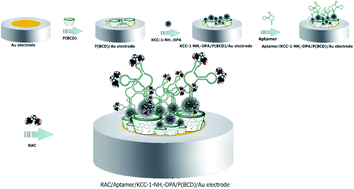d-Penicillamine functionalized dendritic fibrous nanosilica (DFNS-DPA): synthesise and its application as an innovative advanced nanomaterial towards sensitive quantification of ractopamine†
Abstract
During the twentieth century, ractopamine (RAC) as one of the important and frequently used feed additives and doping agents has attracted considerable attention in the animal breeding industry and sports competitions. Due to the low metabolism rate of RAC, it is accumulated in livestock tissues. By consuming food, the residues enter the human body causing hazardous side effects including tachycardia, palpitations, and headache. So, sensitive identification of this compound is desirable to combat illicit use and protect food safety. Here, a novel nanomaterial is manufactured based on the functionalization of dendritic fibrous nanosilica with dipenicillamine (KCC-1-NH-DPA). Synthesised advanced nanomaterial was used for the encapsulation of specific DNA-aptamer and incubated on the surface of gold electrode modified by poly(β-cyclodextrin) P(β-CD) which provided the high surface area, excellent mechanical and thermal stability for the dens-loading of encapsulated aptamer. The green platform was provided an efficient apta-platform for the specific recognition of RAC in human biofluids. Electroanalysis of RAC was performed based on “signal ON” protocol. The modified gold electrode by P(β-CD)-(KCC-1-NH-DPA) was used to improve the conductivity and function of the aptasensor towards sensitive identification of RAC in human real sample. Cyclic voltammetry, differential voltammetry, square wave voltammetry, and chronoamperometry techniques were exploited for the measurement of RAC in the concentration range of 0.1 fM to 0.1 mM. Furthermore, the lower limit of quantification (LLOQ) of engineered aptasensor was obtained as 0.1 fM. It is worth noting that the proposed electrochemical aptasensor showed excellent stability, selectivity and performance in standard and human plasma samples. It is important to point out that, synergetic effect of DFNS with high surface to volume, P(β-CD) as conductive substrate and selective aptamer in the fabricated biodevice lead to highly sensitive and selective biosensor for the biomedical analysis of clinical samples. This platform will be provide a new horizon for the application of advanced nanomaterials in biomedical science based POC analysis.



 Please wait while we load your content...
Please wait while we load your content...